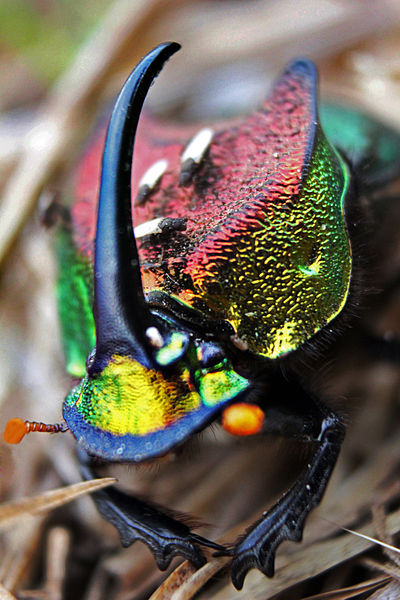Interesting Facts
When an image of a decomposing arthropod comes to mind, a common vision may include a very dull, uninspiring organism. As my partner and I were researching species to further investigate for this website, we experienced the same stereotypical thought, and then we stumbled upon Phanaeus vindex, or the rainbow scarab beetle. From the metallic colors to the large, rhinoceros-like horn, this dung beetle opposes any and all phenotypic stereotype through its undeniably alluring visual display (Emlen 2000). If decomposition just is not your thing, check out an incredibly interesting, non-decomposing arthropod here!
 The complexion of
P. vindex is not only an attempt to visually
please, the vast array of colors also play a functional role in the
life of this beetle. These brilliant colors are presumably used in
attempt to signal others, specifically male to female signaling, in
social situations (Price 2005). The direction of these signals is
two-fold, first in terms of conspecifics (gender-specifics), and
second at diurnal predators (Price 2005). Females that receive
these indicators are consequently less likely to involve themselves
in cross-specific matings (Price 2005)
The complexion of
P. vindex is not only an attempt to visually
please, the vast array of colors also play a functional role in the
life of this beetle. These brilliant colors are presumably used in
attempt to signal others, specifically male to female signaling, in
social situations (Price 2005). The direction of these signals is
two-fold, first in terms of conspecifics (gender-specifics), and
second at diurnal predators (Price 2005). Females that receive
these indicators are consequently less likely to involve themselves
in cross-specific matings (Price 2005)
After an initial reaction to the sheer beauty of P. vindex, focus is typically turned to the large, pronotal horn positioned atop its head. All beetle horns are simply extensions of the exoskeleton stemming from evolutionary processes, and occur in males only (Emlen 2000). As expected, there are an incredible amount of horn variations. Despite this variety, no beetle species, including P. vindex, shed their horns, as elk and moose do (Emlen 2000). In conjunction with the vibrant color scheme of this scarab, the pronotal horn can also be used as a signaling system to females, communicating interspecific differences among males (Price 2005). In addition to potential signaling benefits horns present, they more importantly allow gains in sexual and territorial dominance (Emlen 2000). The males possessing the largest horns are able to assert their power by overtaking questioned territory as well as demanding the attention of potential female acquaintances (Emlen 2000). Although the presence of this horn yields numerous positive aspects for the rainbow scarab beetle, there are evident downsides as well. Horns can account for up to 10% of the beetle’s total weight (Emlen 2000). For a more detailed report on P. vindex's anatomy, click here!
What truly separates this organism from others are its stunning, strangely functional phenotypic modifications. From the vibrant color scheme used as an avenue for communication to the large pronotal horn designed to allow dominance among male beetles, Phanaeus vindex not only exhibits beneficial qualities, but interesting ones as well.
Feeling lost? Click here to go back Home! If not, feel free to browse at our references by clicking here!
To see where we got our information, go to the References page!